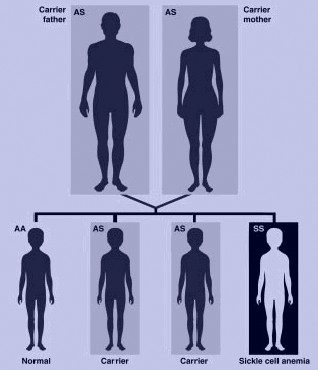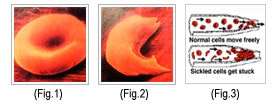What is sickle cell trait?
A person with the sickle cell trait does not have ( and will never have) sickle cell disease. However, the presence of the trait may impact his/her children ( see “How do you get sickle cell disease?”). A person with the trait carries one abnormal hemoglobin gene inherited from one parent ( S, E, C, etc.) and one normal hemoglobin gene from the other parent ( type A). Typically, sickle cell trait is the presence of hemoglobin AS.
How do you get sickle cell disease?
Sickle cell disease is not contagious; you cannot “catch” it. You inherit it from your parents. If, for example, one parent has normal hemoglobin ( type AA) and the second parent has abnormal hemoglobin ( type AS, or the sickle cell “trait”), there is a 50% chance that each child will have the sickle cell trait, but they will not have sickle cell disease ( type SS).

If, however, both parents have type AS hemoglobin (one normal and one abnormal), there is:
- 25% chance that the child will have sickle cell disease.
- 50% chance that the child will have sickle cell trait.
- 25% chance that the child will have neither the disease or trait.
These chances are the same for each child.
Are there different types of sickle cell disease?
The three most common forms of the disease in the United States are:
- Hemoglobin SS or sickle cell anemia
- Hemoglobin SC disease
- Hemoglobin sickle beta-thalassemia (a form of “Cooley’s” anemia)
Each of these can cause very painful “crisis” episodes and in severe cases lead to stroke, heart attack and death.
Who gets sickle cell?
Sickle cell disease affects people of many nationalities including Italians, Latin Americans, Greeks, Arabs, and Asiatic Indians. However, it disproportionately affects people of African descent. All states now screen all newborns for sickle cell. In the U.S., approximately 1 out of 10-12 African Americans has sickle cell trait, and 1 out of 400-500 African American newborns has the disease. Approximately 1 out of 1,000-1,400 Hispanic newborns has the disease.
How can I be tested?
A simple, painless blood test called the hemoglobin electrophoresis can be done by your doctor or local sickle cell foundation.
When should I be tested?
Get tested now for sickle cell! If you are of child-bearing age, you and your partner should be tested immediately so that you can make informed family planning decisions.
How can I help?
If you do not have sickle cell disease, you can help those who battle this disease by:
- Donating blood to your local Red Cross. Sickle cell patients often need multiple blood transfusions to alleviate the painful crisis episodes.
- Being an advocate if your loved one experiences a crisis and enters the hospital. Health care staff may or may not be familiar with sickle cell disease.
- Supporting local and national efforts to increase awareness about the disease.


